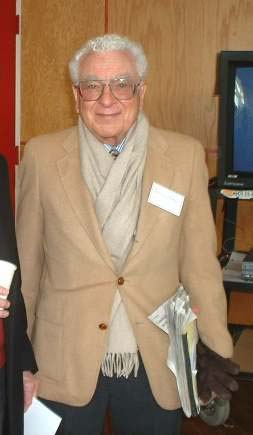
Murray
Gell-Mann
(1929 - )
Murray Gell-Mann (born September 15, 1929) is an American physicist who received the 1969 Nobel Prize in physics for his work on the theory of elementary particles. Born on New York's Lower East Side, Gell-Mann quickly revealed himself as a child prodigy. Propelled by an intense boyhood curiosity and love for nature, he entered Yale at fifteen after graduating valedictorian from the Columbia Grammar and Preparatory School. By age twenty-three he had ignited a revolution, laying bare in his groundbreaking work the strange beauty of the minute particles that make up reality.
Gell-Mann's work in the 1950s involved the understanding of a class of then newly discovered elementary particles which came to be called kaons and hyperons. Classifying these particles led to the idea of a new quantum number called strangeness. One of Gell-Mann's triumphs is the Gell-mann-Nishijima formula, which was, initially, a formula from empirical results, but was later explained by the quark model. Gell-Mann and Abraham Pais were involved in explaining many puzzling aspects of the physics of these particles.
In 1961, this led him (and Kazuhiko Nishijima) to introduce a classification of elementary particles called hadrons (also independently proposed by Yuval Ne'eman at around the same time). This scheme is now explained by the quark model. Gell-Mann's own name for the classifcation scheme was the eightfold way, because of the octets of particles in the classification, and also after the eightfold way of buddhism — a choice that is reflective of Gell-Mann's interests.
Gell-Mann, and, independently, George Zweig, then went on, in 1964, to postulate the quark model. This introduced quarks, the particles of which the hadrons were composed, a name coined by Gell-Mann through a reference to the book Finnegans Wake, written by James Joyce. Zweig had referred to the particles as "aces" but Gell-Mann's name caught on.
Quarks were soon accepted to be the underlying elementary objects in the study of the structure of hadrons. The modern theory of the interactions of quarks is called quantum chromodynamics (QCD), and is based on Gell-Mann's work. The quark model is part of QCD, and has been robust enough to survive the discovery of other flavours of quarks.
Gell-Mann and Richard Feynman working together, and a rival group of George Sudarshan and Robert Marshak, were the first to find the structure of the weak interaction in physics. This work followed the seminal discovery of parity violation by Chien-Shiung Wu, as suggested by Chen-Ning Yang and T. D. Lee.
Gell-Mann continued to be active in physics. In the 1990s his interest turned to the emerging study of complexity, where he was closely associated with the Santa Fe Institute. He wrote a popular science book about these matters, The Quark and the Jaguar: Adventures in the Simple and the Complex. The title of the book is taken from a line of an Arthur Sze poem: "The world of the quark has everything to do with a jaguar circling in the night."
George Johnson wrote a major biography of Gell-Mann, which is entitled Strange Beauty: Murray Gell-Mann and the Revolution in 20th-Century Physics.
Murray Gell-Mann is also a collector of East Asian antiquities, a keen linguist and member of the Editorial Board of Encyclopædia Britannica.
Timeline
He earned a bachelor's degree in physics from Yale University in 1948, and a PhD in physics from MIT in 1951. He was a professor at the University of Chicago before moving to the California Institute of Technology, where he taught from 1955 until 1993. He is currently the Robert Andrews Millikan Professor of Theoretical Physics Emeritus at Caltech as well as a University Professor in the Physics and Astronomy Department of the University of New Mexico in Albuquerque, New Mexico. He is a member of the editorial board of the Encyclopædia Britannica. In 1984 Gell-Mann founded the Santa Fe Institute — a non-profit research institute in Santa Fe, New Mexico — to study complex systems and disseminate the notion of a separate interdisciplinary study of complexity theory.
Awards and honors
* Yale University — Sc.D. (h.c.), 1959
* American Physical Society — Dannie Heineman Prize, 1959
* Ernest O. Lawrence Award, 1966
* University of Chicago — Sc.D.(h.c.), 1967
* Franklin Institute of Philadelphia — Franklin Medal, 1967
* National Academy of Sciences — John J. Carty Medal, 1968
* University of Illinois — Sc.D.(h.c.), 1968
* Wesleyan University — Sc.D.(h.c.), 1968
* Research Corporation Award, 1969
* University of Turin, Italy — Honorary Doctorate, 1969
* Nobel Prize in Physics, 1969
* University of Utah — Sc.D.(h.c.), 1970
* Columbia University — Sc.D.(h.c.), 1977
* University of Cambridge, England — Sc.D.(h.c.), 1980
* United Nations Environment Programme Roll of Honor for Environmental Achievement (The Global 500), 1988
* World Federation of Scientists — Erice Prize, 1990
* University of Oxford, England — D.Sc.(h.c.), 1992
* Southern Illinois University — Sc.D.(h.c.), 1993
* University of Florida — Sc.D.(h.c.), Doctorate of Natural Resources, 1994
* Southern Methodist University — Sc.D.(h.c.), 1999
Courtesy of:
